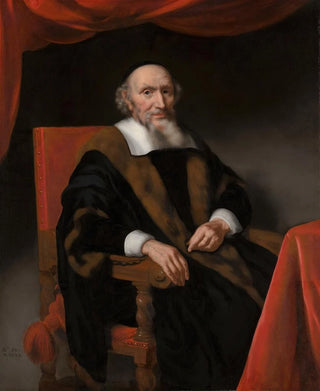Art print | Portrait of Jacob Trip - Nicolaes Maes


View from behind

Frame (optional)
The "Portrait of Jacob Trip" by Nicolaes Maes is an iconic artwork that embodies the very essence of 17th-century Dutch art. This piece, both intimate and majestic, immerses us in the world of an influential businessman of the era, revealing not only his social status but also a fascinating psychological depth. Maes's mastery in depicting textures and lights gives this art print a lively, almost tangible atmosphere. By contemplating this art print, the viewer is invited on a journey through time, to meet a period where art and daily life intertwined harmoniously.
Style and uniqueness of the work
Nicolaes Maes's style is distinguished by his ability to blend realism and sensitivity. In the "Portrait of Jacob Trip," every detail, from the sumptuous costume to the carefully chosen accessories, reflects a meticulous attention to detail characteristic of Maes's art. The play of light and shadow, skillfully orchestrated, highlights the features of Jacob Trip's face, giving him an almost mystical aura. The background, discreet yet carefully crafted, only accentuates the presence of the subject. This art print is not just a simple portrait; it tells a story, that of a man of his time, while revealing the subtleties of human psychology. The work also stands out for its use of color, where rich, deep tones intertwine to create a captivating visual harmony.
The artist and his influence
Nicolaes Maes, a pupil of Rembrandt, established himself in the art world thanks to his undeniable talent and innovative approach. His work is often associated with the Dutch portrait tradition, but he also infused it with his own vision. Maes was a keen observer of the society of his time, and this is reflected in his portraits, which capture not only physical appearance but also the soul of his subjects. His influence extends well beyond his era, inspiring many artists who followed in his footsteps. By revisiting the "Portrait of Jacob Trip," one gains a better understanding of the impact Maes had on the development of the portrait.

Matte finish

View from behind

Frame (optional)
The "Portrait of Jacob Trip" by Nicolaes Maes is an iconic artwork that embodies the very essence of 17th-century Dutch art. This piece, both intimate and majestic, immerses us in the world of an influential businessman of the era, revealing not only his social status but also a fascinating psychological depth. Maes's mastery in depicting textures and lights gives this art print a lively, almost tangible atmosphere. By contemplating this art print, the viewer is invited on a journey through time, to meet a period where art and daily life intertwined harmoniously.
Style and uniqueness of the work
Nicolaes Maes's style is distinguished by his ability to blend realism and sensitivity. In the "Portrait of Jacob Trip," every detail, from the sumptuous costume to the carefully chosen accessories, reflects a meticulous attention to detail characteristic of Maes's art. The play of light and shadow, skillfully orchestrated, highlights the features of Jacob Trip's face, giving him an almost mystical aura. The background, discreet yet carefully crafted, only accentuates the presence of the subject. This art print is not just a simple portrait; it tells a story, that of a man of his time, while revealing the subtleties of human psychology. The work also stands out for its use of color, where rich, deep tones intertwine to create a captivating visual harmony.
The artist and his influence
Nicolaes Maes, a pupil of Rembrandt, established himself in the art world thanks to his undeniable talent and innovative approach. His work is often associated with the Dutch portrait tradition, but he also infused it with his own vision. Maes was a keen observer of the society of his time, and this is reflected in his portraits, which capture not only physical appearance but also the soul of his subjects. His influence extends well beyond his era, inspiring many artists who followed in his footsteps. By revisiting the "Portrait of Jacob Trip," one gains a better understanding of the impact Maes had on the development of the portrait.






